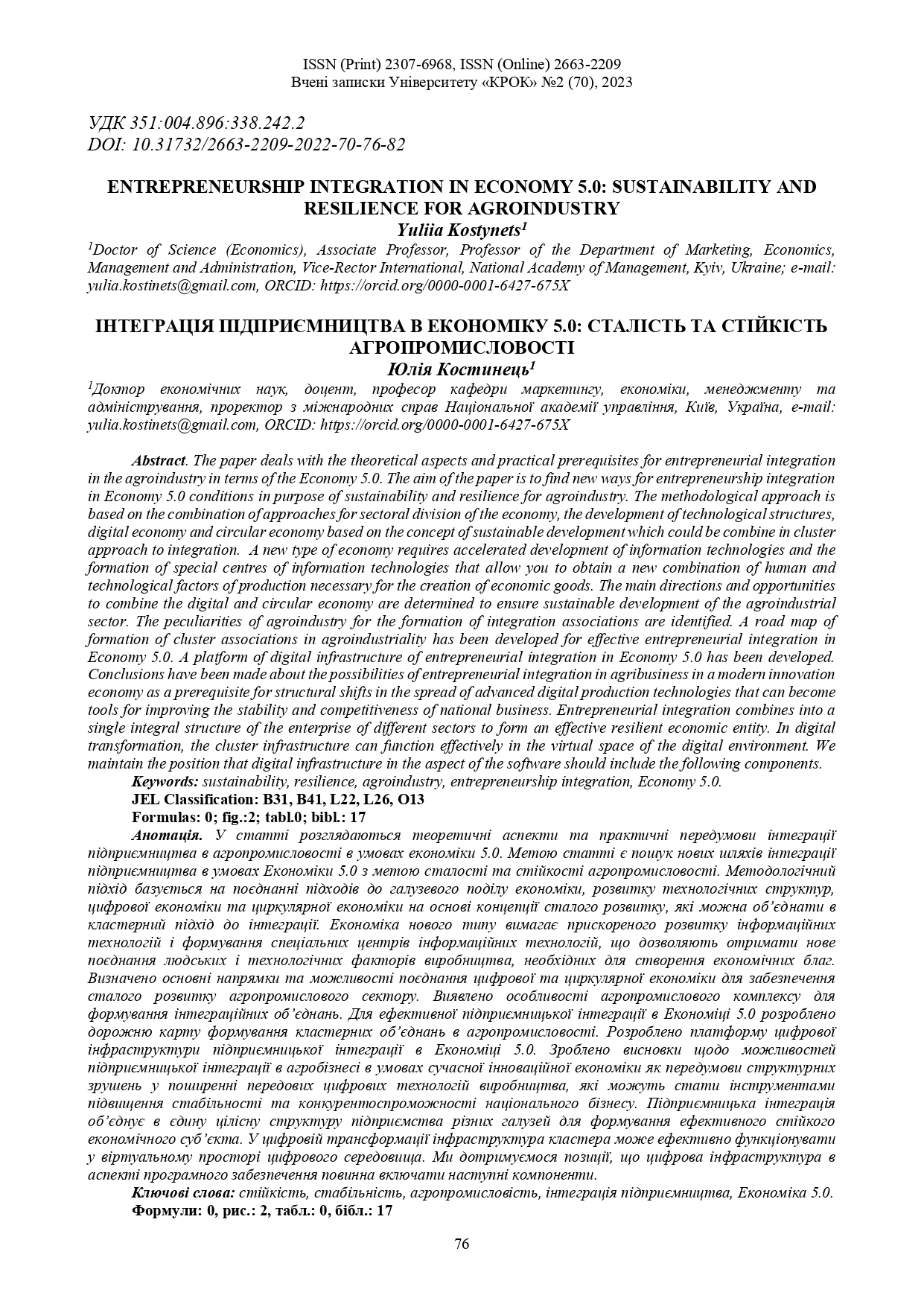ENTREPRENEURSHIP INTEGRATION IN ECONOMY 5.0: SUSTAINABILITY AND RESILIENCE FOR AGROINDUSTRY
DOI:
https://doi.org/10.31732/2663-2209-2022-70-76-82Keywords:
sustainability, resilience, agroindustry, entrepreneurship integration, Economy 5.0Abstract
The paper deals with the theoretical aspects and practical prerequisites for entrepreneurial integration in the agroindustry in terms of the Economy 5.0. The aim of the paper is to find new ways for entrepreneurship integration in Economy 5.0 conditions in purpose of sustainability and resilience for agroindustry. The methodological approach is based on the combination of approaches for sectoral division of the economy, the development of technological structures, digital economy and circular economy based on the concept of sustainable development which could be combine in cluster approach to integration. A new type of economy requires accelerated development of information technologies and the formation of special centres of information technologies that allow you to obtain a new combination of human and technological factors of production necessary for the creation of economic goods. The main directions and opportunities to combine the digital and circular economy are determined to ensure sustainable development of the agroindustrial sector. The peculiarities of agroindustry for the formation of integration associations are identified. A road map of formation of cluster associations in agroindustriality has been developed for effective entrepreneurial integration in Economy 5.0. A platform of digital infrastructure of entrepreneurial integration in Economy 5.0 has been developed. Conclusions have been made about the possibilities of entrepreneurial integration in agribusiness in a modern innovation economy as a prerequisite for structural shifts in the spread of advanced digital production technologies that can become tools for improving the stability and competitiveness of national business. Entrepreneurial integration combines into a single integral structure of the enterprise of different sectors to form an effective resilient economic entity. In digital transformation, the cluster infrastructure can function effectively in the virtual space of the digital environment. We maintain the position that digital infrastructure in the aspect of the software should include the following components.
Downloads
References
Industry 5.0, a transformative vision for Europe (2022) Available at: https://research-and-innovation.ec.europa.eu/knowledge-publications-tools-and-data/publications/all-publications/industry-50-transformative-vision-europe_en
Resilient Industries: Competitiveness in the Face of Disasters (2020). Available at: https://documents1.worldbank.org/curated/en/682501604040773738/pdf/Resilient-Industries-Competitiveness-in-the-Face-of-Disasters.pdf
Fisher A.G.B. (1939) Primary, Secondary, Tertiary Production. Economic Record.
Smith, A. (1976) The Wealth of Nations edited by R. H. Campbell and A. S. Skinner, The Glasgow edition of the Works and Correspondence of Adam Smith
Rostow W. (1960) The Stages of Economic Growth: A Non - Communist Manifesto.
Kostynets V.V. (2015) Theoretical aspects of management of development market development in the national economy. Scientific Bulletin of the International Humanities University, 14, 70-73 (in Ukrainian)
Bergman Е., Feser Е. (2020) Industrial and Regional Clusters: Concepts and Comparative Applies. Avaliable at: http://www.rri.wvu.edu/WebBook/Bergman-Feser/chapter2.htm
Kobets EA (2007) Historical aspects of integration development, its forms and directions. State and regions. Economics and Entrepreneurship Series. 2007, 2, 129-133 (in Ukrainian)
Shamanskaya O. (2012) Theoretical bases of formation and development of agro -industrial integration. Effective economy. 12, Available at: http://www.economy.nayka.com.ua/?op=1&z=1632 (in Ukrainian)
Fedotova Yu.V. (2014) The role of public administration in the implementation of clustering processes at macro and mesoeconomic levels. Utilities of cities: scientific and technical collection. Series: Economic Sciences, 113, 240 – 245 (in Ukrainian)
Pushkar T. (2011) World experience in the formation and development of network and cluster associations. Economic Journal – XXI, 11/12, 68-71 (in Ukrainian)
Dolzhanskii I. (2006) Enterprise competitiveness, Kiev: Center for Educational Literature, 2006, 384 (in Ukrainian)
Fishchuk V. (2017) Digital infrastructure of economic growth. New Time. Available at: https://biz.nv.ua/ukr/ experts/fichuk/tsifrova$infrastruktura$ekonomichnogo$ zrostannja$1408403.html (in Ukrainian)
Porter M. E. (1998) Competitive Strategy: Techniques for Analyzing Industries and Competitors. New York: The Free Press, 397.
Mihus, I., & Koval, Y. (2021). Innovative development of enterprises in the conditions of digitalization of the economy. Science Notes of KROK University, (2 (62), 159–165. https://doi.org/10.31732/2663-2209-2021-62-159-165.
Mihus, I. (2023). The main trends in the development of industry 4.0 and its impact on the economic security of the state: an international aspect. Science Notes of KROK University, (1(69), 52–59. https://doi.org/10.31732/2663-2209-2022-69-52-59.
Mihus, I., Gupta, S.G. (2023). The main trends of the development of the digital economy in the EU countries. The development of innovations and financial technology in the digital economy:monograph.OÜ Scientific Center of Innovative Research. 2023. 230p.PP. 23-41, https://doi.org/10.36690/DIFTDE-2023-23-41.

Downloads
Published
How to Cite
Issue
Section
License

This work is licensed under a Creative Commons Attribution-NonCommercial 4.0 International License.

